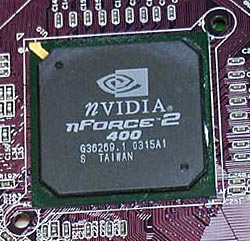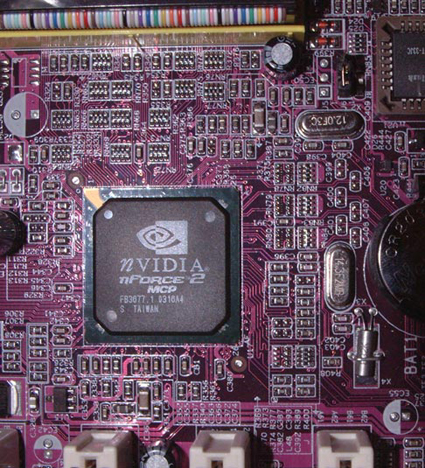Soltek NV400-L64: Purple, Practical, AND Performance!
by Wesley Fink on August 11, 2003 10:26 PM EST- Posted in
- Motherboards
Soltek NV400-L64: Basic Features
| Motherboard Specifications | |
| CPU Interface | Socket-462 |
| Chipset | nForce2 400 Single-Channel North Bridge nForce2 MCP South Bridge |
| Bus Speeds | 100 to 250MHz (in 1MHz increments) |
| PCI/AGP Speeds | Auto (Variable) or Fixed 50-100MHz (in 1 MHz increments) |
| Available CPU Ratios | 5.0X to 22X |
| Core Voltage | 1.10 to 1.85V (in 0.0250V increments) |
| DRAM Voltage | 2.50V to 2.80V (in 0.1V increments) |
| Chipset Voltage | VDD to 1.80V (in 0.1V increments) |
| AGP Voltage | 1.50V to 1.80V (in 0.1V increments) |
| Memory Slots | Two 184-pin DDR DIMM Slots in Single-Channel Configuration |
| Expansion Slots | One AGP 8X Slot Five PCI Slots |
| Onboard IDE | Two Standard ATA133/100/66 (maximum 4 IDE devices) |
| Onboard USB 2.0/IEEE-1394 | Six USB 2.0 ports supported by MCP NO IEEE-1394 FireWire |
| Onboard LAN | nForce MCP 10/100 Ethernet |
| Onboard Audio | Realtek ALC650 codec AC ’97 2.2 Compliant 6-Channel |
| Onboard Serial ATA | None |
| BIOS Revision | Version 1.1 Release BIOS 6/20/2003 |

The Soltek NV400-L64 comes in a slick foil-faced embossed package that is used for many Soltek motherboards. As expected with a value board, extras are a floppy and IDE cable and nothing else. It is worth mentioning, however, that Soltek includes an extra Utility CD with their motherboards that contains PC-Cillin 2002 anti-virus, Farstone’s VirtualDrive 7 and RestoreIT 3 Lite, and Powerquest’s Partition Magic 6.0 SE and DriveImage 4.0. While these are not the latest versions of most of these utilities, they are still utilities that are frequently used. There are two versions of the NV400 listed at the Soltek website. The NV400-L64 and NV400-64 appear the same, except for the 10/100 LAN connection on the NV400-L64, which is the version that we are testing.
Soltek did not use any fancy names for the NV400-L64, but they certainly could have. You can’t help but notice that the board is purple or plum-colored. The purple board is smaller than the full size nForce2 Ultra 400 boards that we have been evaluating, and uses only seven standoffs in two rows for mounting. Full-size boards generally use nine or ten standoffs in three rows for case mounting. This small motherboard should have no trouble fitting into any standard case.

Sound is provided by the common Realtek ALC650 chip, which is compliant with AC ’97 2.2 to provide 6-channel sound. AC ’97 2.2 seems to have replaced older AC ’97 chips, which now makes 6-channel sound mainstream. Audio quality is OK for casual listening or computing, but audio enthusiasts will want to use a separate audio card for top quality. The on-board audio can be disabled in the BIOS if you wish to use a separate audio card. Only the three standard output jacks are provided for audio input and output on the I/O panel, but software that comes with the NV400-L64 does allow the three jacks to be configured for different speaker setups, and the inputs that you might need. This flexible setup is welcomed on a value board, but be aware that with three jacks, you cannot simultaneously run six speakers and a microphone. This will be important for some, and of no consequence to others. As we would expect on a board built for value, there are no SPDIF connectors or provisions for adding an SPDIF bracket to the board.

NVIDIA’s MCP SouthBridge is the value member of the MCP family. It provides USB support, support for one NVIDIA Ethernet connection, and ATA 133 IDE support. The MCP does not support NVIDIA Sound Storm or a second LAN connection — these are additions to the premium MCP-T.
The Soltek NV400-L64 uses the familiar nForce2 10/100 Ethernet for on-board LAN connection. It is becoming common to see LAN included, even on value boards like the NV400. If you prefer using a board without on-board LAN, the alternative is the NV400-64.

The NV400-L64 I/O ports are the same assortment you will find on the standard ATX backplate included with most cases. The arrangement of ports, however, does not follow the standard layout, so Soltek includes a custom backplate. There are two PS/2 ports, two serial ports, one parallel port, two USB 2.0 ports, a 10/100 LAN port, and Mic In, Line In, and Line Out, which drive the onboard sound and are configurable for rear/sub/center outputs if desired. The board does not offer any IEEE1384 Firewire ports, but we don’t normally expect to find Firewire on value motherboards.
There are two ATA133 IDE ports, supporting up to four IDE devices. It is no surprise that the NV400-L64 doesn’t have any on-board IDE RAID or SATA options.
Just two DIMM slots are included on the single-channel Soltek. The two DIMMs support up to 2GB of memory up to DDR400. While up to three DIMMs per channel can be used on the nForce2 400 chipset, Soltek decided to use just two DIMM sockets on the NV400. This is probably an acceptable arrangement on a value board, but we would like to have seen at least one more DIMM slot, since NVIDIA had intended for this Soltek single-channel to compete with KT600 boards with three DIMMs.
There are no real surprises with the Soltek NV400-L64. It includes exactly what we would expect in a value board – no more and no less. The only really distinctive thing about the appearance is the Purple color. The Soltek Utilities CD is also a nice addition for a board designed to sell for such a low price.










35 Comments
View All Comments
Anonymous User - Saturday, October 25, 2003 - link
Hello All!!!I've been buying components last 6 months one at a time, and the Soltek Nv400L was my last purchace.
System Specs:
430 Watt Antec Power Supply
Athlon XP 2500 cpu
512 Corsair Xms c2pt memory-single stick
Ati 9500 pro 128 video card
Turtle Beach Santa Cruz sound card
1 80 gig Western Digital 8meg cache hard drive
1 80 gig Maxtor 8meg cache hard drive
Liteon 522446s Cd writer
Liteon 165h Dvd rom
Philips Brilliance 107p monitor
Windows XP professional
I don' need serial ata, my special editions are plenty fast for the dollars spent, serial needs to mature also. I had a Kt3ultra2, with pc2100 Infineon 512 stick, and a XP2000.
I was concerned about this upgrade, I don't trust cheap boards. Had real bad time with a ECS pos last year.
Let me tell you, my system right now, is THE best bang for the buck. I am so impressed. All I needed was the lan, and it too kills my pci network card. This Soltek mobo should not be understated, to say the very, very least. I also like the fact of just having my one stick of corsair, ranther than having 2 dual sticks. If you need all the "features", pass on it. If you want amazing speed, ultra reliability, and great overclocking (Soltek has O/C bios at request, FULL ram tweaking), grab this board.
I can't believe something this cheap is so damn fast, reliable.............
Don't be fooled people. Ya, I have no bragging rights, but I have a great little purple mobo on crack, HIGHLY SUGGESTED.
THIS IS THE MOST UNDERATED MOBO ON THE MARKET RIGHT NOW. ABSOLUTELEY. You don't hear much about it cause Nvidia etc. etc. is not getting rich off it. Its a gem.
Anonymous User - Wednesday, August 27, 2003 - link
Can't see the benchmarks, too. Using Netscape7 on Linux.Anonymous User - Monday, August 25, 2003 - link
Uhh... Did something happened to the benchmark pics? (They are not showing up) Anyone else experiencing this? or Is my browser acting up?Maybe another ongoing article update perhaps?
Anonymous User - Wednesday, August 20, 2003 - link
To the author,PCI bus speed runs at a fixed frequency for nForce2. It isn't half of the AGP bus speed. Please use a IOSS RD2 Pro PC Geiger PCI Bus Multifunction Analyzer to verify.
Anonymous User - Tuesday, August 19, 2003 - link
Jeff, stop posting, it's already known fact that Gigabyte's nForce2 U400 and other U400 motherboards perform exactly the same as Epox and ASUS's boards. Your argument request is useless, waste's Anandtech's time, and is getting old frankly.Anonymous User - Sunday, August 17, 2003 - link
I'm really surprised by the figures you guys obtained - I had an ASUS A7N8X-X (non-ultra) and it was crap! I could only get 8,000 in 3Dmark01, upon changing to the ASUS Ultra (deluxe) and keeping everything the same I got 13,500!!!!Also, my A7V8X-X was way faster (12,000 3DMark01) - Don't know why, maybe the A7N8X-X was not working correctly(?).
Jeff7181 - Sunday, August 17, 2003 - link
Again I ask... where the hell is the popular boards like the A7N8X Deluxe and 8RDA+?Anonymous User - Sunday, August 17, 2003 - link
is a7n8x-x anygood?Anonymous User - Saturday, August 16, 2003 - link
I am awaiting further testing on other nForce2 400/Ultra motherboard, e.g. chaintech 7njl3 or 7njl4 or gigabyte counterparts which are also very competitive in the market.wesley, hear my voice?!
Anonymous User - Saturday, August 16, 2003 - link
And one last question - is it not possible that the 'Auto' setting for memory speed actually runs the memory in sync with FSB? I just want to be sure.